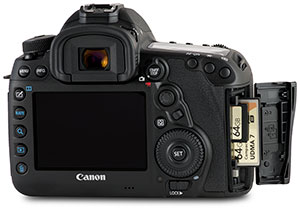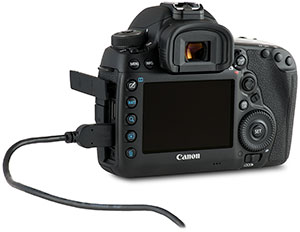Cannon 5d Mark Iv Wont Read Sd Card

Fastest SD and CF Cards for the Canon 5D Mark Four
Published: January 26, 2017
The Canon EOS 5D Marking Four is the latest update in the venerable 5D series. A new 30.4MP total-frame sensor and Digic 6+ processor are combined with advanced autofocus features from the 1D 10 Mark Two. Its video capabilities have been expanded to include 4K recording at 24 and 30p. The Marker Four provides up to 7fps continuous shooting.
The 5D Mark 4 features 1 CompactFlash and one Secure Digital carte du jour slot. The CompactFlash slot supports UDMA7 cards while the Secure Digital slot accepts SD/SDHC/SDXC cards and supports UHS-I. The 5D Mk IV does non support UHS-II cards because it lacks the pins to connect to the high speed interface, notwithstanding UHS-Ii cards are backwards uniform and will operate at UHS-I speed in the photographic camera.
A total of 139 retention cards were tested in the camera: 114 SD cards and 25 CF cards. The SD cards include both UHS-I and UHS-II cards, while nearly all CF cards back up UDMA7. The results in the tables beneath testify write speed for continuous shooting of RAW images and the number of shots that tin can be taken in thirty seconds of continuous shooting for RAW+JPEG, RAW and JPEG image modes. Following the results, an analysis provides additional data gathered from the tests. From these tests the fastest SD and CF cards for the 5D Marking 4 are provided.
Camera Details and Settings
- Photographic camera: Catechism EOS 5D Mark IV
- Test date: September fifteen, 2016
- Firmware version: one.0.1
- File size (average):
- RAW: 38.5 MB
- JPEG: 14.0 MB
- Each carte is formatted in camera using low level format
- Camera settings:
- Manual exposure fashion
- Manual focus
- JPEG: Fifty, high quality
- Continuous high bulldoze style
- Dual Pixel RAW disabled
- Image review off
- Lens aberration corrections disabled
- ISO 100
- Auto lighting optimizer disabled
- Custom white balance
- sRGB color infinite
- Standard flick style
- Long exposure NR off
- High ISO speed NR off
- Highlight tone priority off
- Aspect ratio 3:ii
- Wi-Fi/NFC disabled
The test uses a manual lens and manual photographic camera settings. The 5D Iv is mounted on a tripod and activated using a remote timer. The subject field is a detailed examination scene illuminated past controlled lighting.
Write speed is calculated using the buffer full condition during extended continuous shooting; the total amount of data written to the menu divided by the write time. This calculation provides a more accurate upshot than the bill of fare access light because the the light turns on when the shutter is get-go activated rather than when the prototype has been candy and begins writing to the card. Write speed is in megabytes per second MB/s (i MB = one,048,576 bytes). Write speed is provided for RAW image mode. Shooting RAW+JPEG and JPEG only result in lower write speed.
Canon 5D Marker Four Write Speed Comparison
Catechism 5D Mark IV Continuous Shooting
The post-obit table shows the number of shots taken in xxx seconds of continuous shooting using the 5D Mark Iv. The time does not include the buffer immigration or write time. The test is repeated for three image modes: RAW+JPEG, RAW, and JPEG. The JPEG setting is large, high quality. The camera is set to continuous loftier drive mode. Boilerplate RAW file size is 38.5 MB. Average JPEG file size is 14.0 MB. The detailed test scene used in these tests results in large file sizes. The number of images may exist lower than what may be experienced during actual apply, depending on the image field of study. Images with less detail create smaller file sizes allowing more images to be written in the same time period.
Analysis
The Canon 5D Mark IV provides UHS-I back up including SDR104 mode for high write speed. The camera does not support UHS-Two because information technology lacks the pins to interface the UHS-Two motorbus; however, UHS-2 cards tin exist used in the camera considering the cards have the standard SD contacts and revert to UHS-I fashion. UHS-II cards offer no speed benefit in the camera compared with fast UHS-I cards, but do provide the ability to download images faster when used in a UHS-Ii card reader.
As can be seen in the first table, the fastest retention cards in the 5D Mark Iv are all CompactFlash cards. In RAW mode the fastest CF cards averaged up to 112 MB/s, while SD cards provided up to nearly 79MB/s boilerplate speed during continuous shooting. These are slightly faster the average speeds measured in the 5Ds, which were 102 MB/s with CF cards and 72MB/s with SD cards.
The buffer capacity of the 5D Mk IV in RAW mode varied from 16 to 21 shots, depending on the memory card. This is the number of shots that can be taken at total frame rate before the frame rate drops. This number changes with different camera settings, image subjects and card write speed. Because the photographic camera writes to the card while it is withal shooting, a faster carte du jour will clear infinite and allow more shots at total frame rate. This number is slightly higher than the 15-18 shots of the 5Ds, but the file size in the 5D Four is significantly smaller.
When comparing retentiveness cards it is important to realize that a slow memory bill of fare limits the camera later the camera has reached its buffer chapters. At that betoken the camera only takes additional pictures at the same rate it can write to the card. When using slow SD cards the frame charge per unit dropped to below 0.3 fps when shooting RAW images. The fastest SD cards could sustain nearly 2 fps, while the fastest CF cards could shoot iii fps with the buffer at chapters. When shooting JPEG the slowest SD menu provided about 36 shots before the frame rate dropped to about 0.6 fps, while fast SD cards could shoot over 100 shots before the frame charge per unit slowed and connected at over 5 fps. With fast CF cards JPG shooting was not limited by the memory card and the high frame rate could be sustained for the thirty 2d duration of the test.
Since the Catechism 5D Mark Four has two card slots, various combinations of using ii cards in the photographic camera were tested. In these tests the Lexar Professional 1066x 32GB and SanDisk Extreme Pro 95MB/south U3 32GB cards were used. Starting time, writing to both cards in backup fashion the camera was able to capture images upward to the speed of the slower of the two cards, in this case it was limited by the SD card. In thirty seconds of shooting the camera captured 47 shots RAW+JPEG, 72 shots RAW and 184 shots JPEG, nearly the same every bit shooting to the SD carte only.
The second test was recording separately, RAW to the CF card and JPEG to the SD card. In this test up to 71 shots were captured in thirty seconds of continuous shooting. This is below the 99 RAW that tin can be taken when shooting RAW only to the CF card, simply above the 67 shots when writing both RAW and JPEG to the CF card.
Fastest CF Cards for the Catechism 5D Mark IV
The fastest retentiveness carte in the Catechism 5D Marking IV is the Lexar Professional 1066x 128GB CF Card. This card averaged slightly faster write speed simply offered like performance to the 64GB and 32GB capacity versions of the same card. The SanDisk Extreme Pro, Transcend 1000x and Komputerbay 1066x 128GB cards performed most as well, all within one shot deviation in thirty seconds of continuous shooting. Ane would be hard pressed to tell the difference in actual apply between any of these cards in the 5D Mark 4.
When considering SD cards for the Catechism 5D IV the commencement thing to annotation is that UHS-II cards offering no speed benefit in the camera. With that in heed, the SanDisk Farthermost Pro UHS-I and Lexar Professional 2000x UHS-2 cards ended up in a virtual tie for fastest SD card. The difference between these cards can exist experienced when downloading images with a UHS-2 carte reader. The UHS-II card hands outperforms the UHS-I card in read speed. (Information technology should be mentioned that the older SanDisk Extreme Pro UHS-Two 32GB SD card did not perform as well as other UHS-II cards considering that particular carte does not back up SDR104 UHS-I bus way and operates at lower 50MB/s bus speed, whereas the newer Extreme Pro UHS-II microSDXC 64GB carte does support the faster SDR104 coach manner.)
The fastest cards in the 5D Iv are CF cards. SD cards, peculiarly those that support high write speeds (usually noted equally 90MB/s), offer good operation in the camera and are priced lower than similar capacity CF cards. During extended continuous shooting the difference becomes apparent and faster CF cards offering a noticeable comeback over SD cards by clearing the buffer faster and maintaining a higher frame charge per unit subsequently the buffer reaches capacity.

Downloading images from the Canon 5D Mark IV
The Canon 5D Iv has an integrated USB 3.0 port that allows images to exist transferred straight to a figurer. To test this transfer method Secure Digital and CompactFlash cards with 7GB of RAW images were used. The camera was connected using a USB three.0 cable and images were transferred to a fast SSD drive in a reckoner. The Lexar 1066x 32GB CompactFlash card completed the transfer in 108.five seconds and averaged 61.2 MB/s. The SanDisk Extreme 95MB/s UHS-I U3 32GB SD carte du jour took 185.5 seconds at an average transfer charge per unit of 35.viii MB/s. The CompactFlash transfer rate was just slightly in a higher place the 53.4 MB/s speed measured in the 5Ds, however the SD card transfer rate was well below the 65.4 MB/due south of the 5Ds.
The preferred method to transfer images when speed is important is to utilise an external memory card reader. Transfers of RAW images from SD cards using a USB 3.0 card reader typically average 90 MB/s with UHS-I cards and 250 MB/due south for UHS-2 cards. CompactFlash cards can reach 140MB/s copying actual RAW files using a USB three.0 card reader. Several card reader tests with various memory cards tin exist constitute in the Card Reader Reviews.
Source: https://www.cameramemoryspeed.com/canon-5d-mark-iv/sd-cf-card-speed-test/
Post a Comment for "Cannon 5d Mark Iv Wont Read Sd Card"